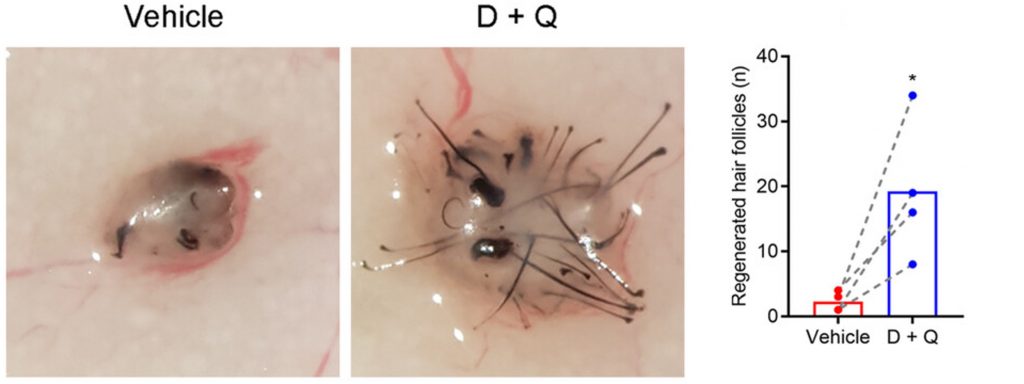Key Points:
- Among three senolytic compounds, dasatinib plus quercetin (D + Q) is most effective at reducing age-promoting cells that may hinder hair regrowth.
- D + Q promotes hair growth by increasing the number of regenerated hair follicles in the skin of hairless mice injected with hair growth cells.
Scientists have recently identified senescent cells — age-promoting cells — as one of the root causes of aging. Senescent cells play a critical role in multiple age-related diseases, including cardiovascular disease, dementia, and cancer. However, little research has been done to determine how senescent cells affect hair loss, a familiar outward feature of aging.
To help fill the gap, researchers from Columbia University tested the effect of senolytics — compounds that remove senescent cells — on hair regrowth. Their results, published in Aging Cell, are promising, showing that removing senescent cells restores hair growth. Along with previous mouse studies, Columbia University’s findings pave the way towards senolytics becoming a treatment for age-related hair loss.
Most Potent Senolytic: Dasatinib plus Quercetin
At the base of each of our hair follicles reside a cluster of stem cells called dermal papilla (DP) cells. Without DP cells, our hair cannot regrow. For this reason, Columbia University researchers examined human DP cells donated by participants. To model aging, the researchers grew the human DP cells in a dish, allowing them to divide several times. As a result, they found an increase in senescent cells.
To reduce the number of accumulated senescent cells amongst the DP cells, the researchers employed three different senolytic regimens. They found that the senolytic combo dasatinib plus quercetin (D + Q) outperformed the other two senolytics (i.e., Navitoclax and Venetoclax). These findings suggest that senescent cells may play a role in age-related hair loss and that D + Q could potentially counteract this hair loss.

Dasatinib plus Quercetin Promotes Hair Growth
To investigate the effect of D + Q on hair growth, the researchers injected D + Q-treated human DP cells into the skin of hairless mice. After three weeks, the skin was harvested and the number of hair follicles was counted. The results revealed that D + Q treatment increased the number of regenerated hair follicles, suggesting that D + Q can promote hair regrowth by removing senescent cells.

Can Senolytics Deter Age-Related Hair Loss in Humans?
A previous study showed that removing senescent cells by genetic manipulation can partially reverse age-related hair loss in mice. The same results could potentially be found in mice that ingest senolytic compounds such as D + Q, although the oral intake of medicinal compounds is usually less potent than genetic manipulation due to issues with absorption and metabolism. Thus, more research is needed to determine if the oral intake of senolytics can deter age-related hair loss in mice.
Furthermore, there is currently a lack of evidence showing that senolytics can deter age-related hair loss in humans. With that being said, the current generation of senolytic compounds available do not specifically target hair follicles. Most senolytic compounds target senescent cells found throughout the body and may have effects, positive or negative, beyond hair regrowth.
Additionally, pharmaceutical-grade senolytics like dasatinib may have more severe side effects than naturally occurring senolytics such as quercetin, particularly if the naturally occuring senolytics are consumed in the form of food and drink. Quercetin can be found in plant-based foods like apples, onions, and green tea. When it comes to mega-dosing quercetin and other naturally occurring senolytics, more research is needed to determine the long-term side effects.